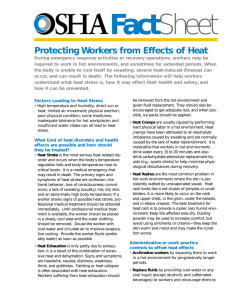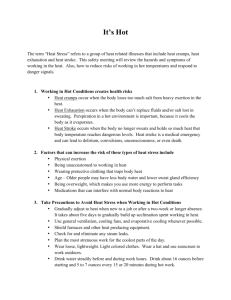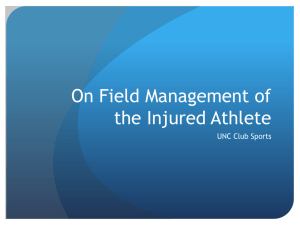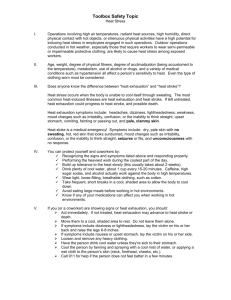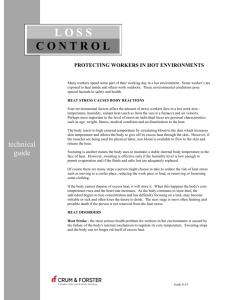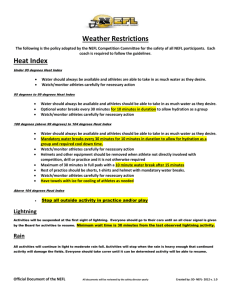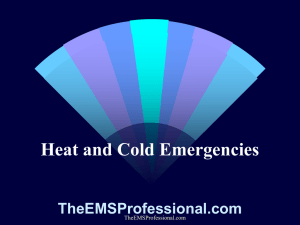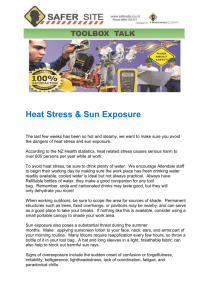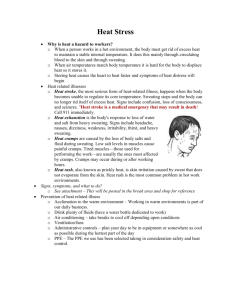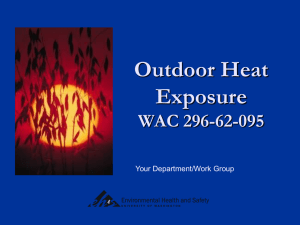ADOSH-Heat-Stress-Awareness
advertisement
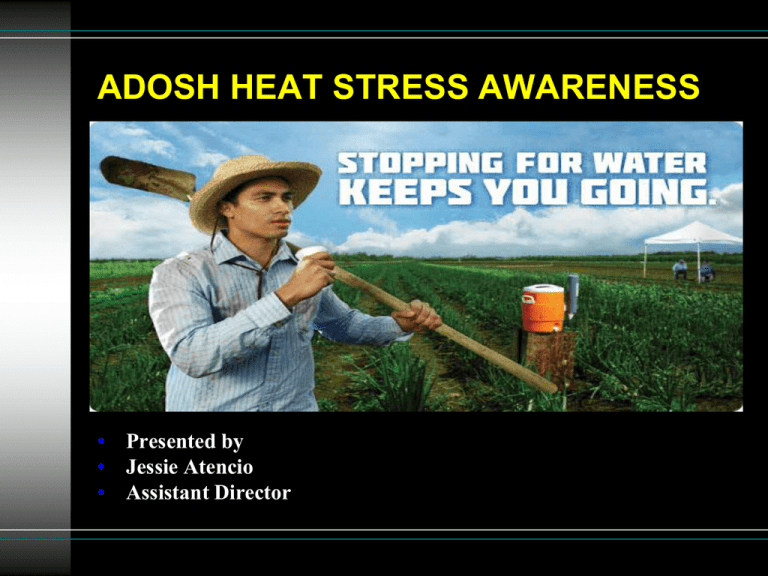
ADOSH HEAT STRESS AWARENESS • Presented by • Jessie Atencio • Assistant Director Objectives • • • • Who is ADOSH Heat & Statistics What is Heat Stress Signs & Symptoms • First Aid • Training • Developing a Plan • Questions Who is ADOSH????? • The Arizona Division of Occupational Safety and Health • Two Offices: Phoenix & Tucson • Charged with enforcing federal and state occupational safety and health (OSHA) standards. • State run plan • Compliance Inspectors • Imminent Danger, Fatalities, Complaints, Referrals, and Program Planned Inspections • Consultation & Training Services • Surveys/Training/Outreach programs Statistics cont’d… # Heat-related Incidents 2005 2006 2007 2008 Lost-time Illnesses Nationwide 2610 3110 2550 1660 Fatalities Nationwide 47 44 32 27 Fatalities in Arizona 4 1 0 1 • Describe the workers most affected heat? • • • • Most fatalities & non-fatal illnesses involved men. Predominant ages affected: 25 - 55 years old. Most illnesses occurred between noon and 4 pm. Most common worker activities were agriculture, construction, materials handling, using and operating tools and machinery, and other physical activities. • Tucson averages 55 days per year at or above 100ºF. What is Heat Stress???? • Working or playing where it is HOT puts STRESS on our body's cooling system. • When the heat is combined with other stresses such as hard physical work, loss of fluids, inappropriate diet, heavy clothing, medicines and/or some health conditions, it may lead to heat-related illness, disability and even death. • This can happen to anybody - even someone who is young and fit. Types of Heat Stress • • • • Heat Stroke Heat Exhaustion Heat Cramps Heat Rash Heat Stroke • The most serious heatrelated disorder • Occurs when body becomes unable to control its temperature: the body’s temperature rises rapidly, the sweating mechanisms fails, and the body is unable to cool down. • When heat stroke occurs, the body temperature can rise to 106 degrees Fahrenheit or higher within 10 to 15 minutes. Heat stroke can cause death or permanent disability if emergency treatment is not given. Symptoms of Heat Stroke • • • • • • • Hot, dry skin or profuse sweating Hallucinations Chills Throbbing headache High body temperature Confusion/dizziness Slurred speech First Aid for Heat Stroke • Take the following steps to treat a worker with heat stroke: • Call 911 and notify supervisor • Move the employee to a cool shaded area • Cool the worker using methods such as: • Soaking their clothes with water • Spraying, sponging, or showering the with water • Fanning their body Heat Exhaustion • Heat exhaustion is the body’s response to an excessive loss of the water and salt, usually through excessive sweating • Workers most prone to heat exhaustion are those that are elderly, have high blood pressure, and work in a hot environment Symptoms of Heat Exhaustion • • • • • • • • Heavy sweating Extreme weakness or fatigue Dizziness, confusion Nausea Clammy, moist skin Pale or flushed complexion Muscle cramps Slightly elevated body temperature • Fast and shallow breathing First Aid for Heat Exhaustion • Treat a worker suffering with heat exhaustion with the following: • Have employee rest in a cool, shaded or airconditioned area • Drink plenty of water • Take a cool shower or bath Employer Prevention.. • Employers should take the following steps to protect workers from heat stress: • Schedule maintenance and repair jobs in hot areas for cooler months. • Schedule hot jobs for the cooler part of the day. • Acclimatize workers by exposing them for progressively longer periods to hot work environments. • Reduce the physical demands of workers. • Use relief workers or assign extra workers for physically demanding jobs. • Provide cool water or liquids to workers. • Avoid drinks with caffeine, alcohol, or large amounts of sugar. • Provide rest periods with water breaks. • Provide cool areas for use during break periods. • Monitor workers who are at risk of heat stress. Employee Prevention…. • Workers should avoid exposure to extreme heat, sun exposure, and high humidity when possible. When these exposures cannot be avoided, workers should take the following steps to prevent heat stress: • Wear light-colored, loose-fitting, breathable clothing such as cotton. • Avoid non-breathing synthetic clothing. • Gradually build up to heavy work. • Schedule heavy work during the coolest parts of day. • Take more breaks in extreme heat and humidity. • Take breaks in the shade or a cool area when possible. • Drink water frequently. Drink enough water that you never become thirsty. • Avoid drinks with caffeine, alcohol, and large amounts of sugar. • Be aware that protective clothing or personal protective equipment may increase the risk of heat stress. • Monitor your physical condition and that of your coworkers. Who Is At Risk To Heat Illness??? Who Is At Risk To Heat Illness cont’d? • Workers in a variety of industries • Roofing Contractors • Scheduled passenger air transport • (job tasks on the tarmac, including baggage handlers) • Car Dealers • Farm labor contractors and crew leaders • Water transportation • Poured concrete foundation and structure contractors • Landscaping services • Highway work • Nursery • Oil and gas operations Employee Training • Provide heat stress training that includes information about: • Worker risk • Prevention • Symptoms • The importance of monitoring yourself and coworkers for symptoms • Treatment • Personal protective equipment Training & Planning in the event of a Heat Illness • • • • • Call 911 Move worker to cool, shaded area Loosen or remove heavy clothing Provide cool drinking water Fan and mist the person with water Develop a Heat Stress Prevention Program • Best Practice for outside workers • Monitor for “dry bulb temperatures” that exceed 85 F • Provide 2 gallons of cool, clean water per employee (1 quart per hr). • Provide easily accessible shade (2 ½ minute walk), may include sitting in vehicle if air conditioned • Provide preventive recovery periods (at least 5 minutes long), when worker exhibits indications of heat illness • Provide emergency action plan • Provide medical attention • Provide “Heat Stress Training” for workers and supervisors • “Heat Safety Daily Checklist” Develop a checklist… • http://www.99calor.org/_downloads/Employers_trainin g_Kit/daily_checklist_english.pdf ADOSH Example How Is ADOSH Providing Awareness???? • Billboards • Radio Commercials (English/Spanish) • Flash Cards • Posters • Consultation & Training providing classes through the State of Arizona • Toll free number to call (855) 268-5251 Awareness examples cont’d. Billboards in San Luis/Yuma Area Sample Training Material Sample Material cont’d… Federal OSHA Website • http://www.osha.gov/SLTC/heatillne ss/index.html • “Heat Illness Prevention Campaign” • Web-page dedicated to outdoor workers • Videos • Educational material • Training • Heat App for Smart Phones • Heat index tools • All printable from home printer or office (pdf) and free Additional Information • ADOSH has two offices • Phoenix – 800 W Washington St, Phoenix, AZ 85007 • (602) 542-1769 • Tucson – 2675 E Broadway Blvd #239, Tucson, AZ 85716 • (520) 628-5478 • atencio.jessie@dol.gov Questions???? • Thank you!!!!!
